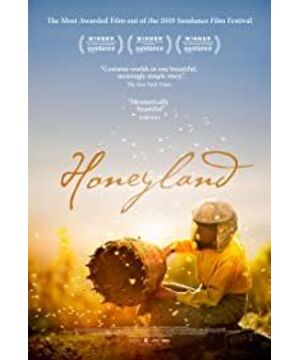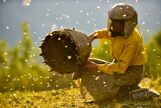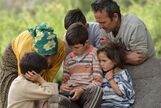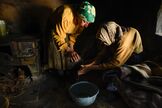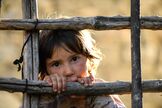On the uninhabited plateau of the Balkan Peninsula, a middle-aged woman in a floral turban and an old yellow dress is walking.
Carrying a cloth bag, she climbed steadily up the cliff, her thin body clinging to the cliff, carefully removing the stone from the crevices of the cliff, hiding a golden honeycomb inside, and flying out a swarm of wild bees, she took with her She smiled and puffed a little hookah, the wild bees did not attack her, then she opened the hive with her hands, took half of it and put it back in the stone crack, and sealed it with stones, she said to herself: I only take away half, half for you.
The documentary "HoneyLand" from Macedonia won several awards at the most prestigious Sundance Film Festival in the United States in 2019, and subsequently won awards at important film festivals around the world, and was finally nominated for two at the 2020 Oscar Film Festival. Awards, Best International Feature Film, Best Documentary Film, and a few days before the final announcement on Oscars night on February 9, will this film get an Oscar? No doubt!
Macedonia, a small country burdened with too much history, is the poorest country in the mild and rich land of the Balkans. It originally belonged to Yugoslavia. After the disintegration of Kosovo and Serbia, wars continued. The ethnic languages of the Balkans are complex, with Turkish, Greek, Albanian, and Bulgarian people traveling back and forth, and Orthodox, Muslim, and Catholic mixed together. The country disintegrated, the land was re-divided, and the nomads moved around with their cattle and sheep, but also for a meal.
"The Land of Honey" is a 85-minute documentary film by two young Macedonian directors who spent three years shooting more than 400 hours of material.
The protagonist of the film, Hadiz, is a middle-aged single woman who lives by picking wild honey and lives with her half-blind mother. She lives in an uninhabited village. The villagers have all moved away. She is the only one in this small village. In order to take care of her mother, she did not marry and missed the opportunity to marry. There is no electricity in the village, and she can barely maintain the life of her mother and daughter by selling wild honey.
Until one day, a family of Turkish nomads moved to the village, dragged their family with six children, an abandoned RV, and a herd of cattle, breaking the peace of the village and raising cattle could not make a living. This family also learned Beekeeping, in order to raise bees quickly, sell more honey, do not listen to Hadiz's advice, do not hesitate to destroy the original natural environment of wild bees, honey died, and finally beekeeping failed, and left the dilapidated village with the whole family and herd to go to Elsewhere.
The village restored Hadiz's life by herself. Her mother also died. Before her mother's grave, she felt lost. In the end, she walked alone among the plateaus of the Balkans and continued to live the days of picking wild honey.
Film art includes ideological realms and artistic techniques. No matter how poor European films are, the aesthetic awareness brought by the art creators is also outstanding (related to European history and culture). Even if they express the primitive and backward environment without electricity, poverty is not crude. It is like a heavy oil painting of a figure intertwined with a bright watercolor painting, forming a symphony of destiny in which man and nature live together.
The theme of the film makes people realize that for the better survival of wild bees, beekeepers only take half of the honey and leave half to nature. If greed takes all, nature will be destroyed and people will not be able to survive.
Why do people take it all? Because taking all can sell more money, greed is human nature, the distribution of social resources is unfair, the poor have no way to get rich, they can only ask nature, the silent mother, and nature is in the same predicament as human beings.
The evil consequences of human beings destroying nature have shown karma in recent years. All the causes of destroying nature come from human greed. Selfish capitalists need better enjoyment and more production. In order to maintain life, people at the bottom can only survive. Become the most primitive tool to destroy nature.
The law is also a decision of the upper classes, and their own interests are considered first when making laws. If the society can solve the huge difference caused by the inequality of wealth and the poor, it can solve the dilemma of advancing and retreating between nature and human beings.
Why does a country with a smaller gap between the rich and the poor have a better natural ecological environment? In addition to strict laws, the main thing is that there is no huge gap between rich and poor, such as northern Europe. The larger the gap between the rich and the poor, the worse the natural protection environment, such as India and Brazil.
Going back to the film "The Land of the Bees", the film creator can spend 3 years shooting 400 hours of material in the poorest places. It is a kind of love for nature and a decision to express the truth to the world.
Filming equipment is the most basic, only aerial photography is used for the opening and closing shots. It is very difficult to shoot in the poorest places. There are only 4 people in the crew who have to take turns to shoot. Documentary is not a money-making project, it is completely ideal and belief.
It is normal for two directors to co-produce a film. After three years of filming in a difficult environment, one director cannot support it and cannot make it in a hurry like a commercial film. The two directors have different visual languages to express their grand and profound thoughts and themes. Well blended.
The aesthetics of European directors lies in the nurturing of the foundation of the growth environment and the aesthetic foundation left in the blood. Even poverty is a balance between nature and culture.
The texture and tone of the interior pictures in the movie reminds people of the Rembrandt-style oil painting style, and the heaviness brought to the theme of the movie is well balanced.
The language of the shots of the film does not change much, it fully shows the nature, and the nature is truly revealed. The narrative is quite concise, there are no wordy things, no cool shots, and no complicated lighting design. It completely emphasizes the most important thing in the relationship between human nature and nature. That part of the feeling.
Modern commercial movies are full of tricks, tricks, floods, and clichés, for entertainment.
The appearance of this film is like Van Gogh's paintings suddenly placed in a pile of pretentious portraits of noble ladies. How many filmmakers use the hard way of making films to awaken people's awe and protection of nature?
The recent new pneumonia epidemic in China, the ultimate cause of this disaster is the gap between the rich and the poor, the virus of wild animals brings disaster, catching wild animals is because of poverty, selling wild animals is for profit, eating expensive wild animals is To be rich.
How to solve the social problems caused by the inequality of the rich and the poor, the film expresses the concept of leaving half of itself for the earth with a precious spirit of sacrifice.
Humans, who are constantly pursuing wealth, have not learned to respect Mother Earth. If her milk is drained, where is our way out?
Please pay attention to the literary public account "Sisyphus Garden" The author is from Austin, Texas, USA
View more about Honeyland reviews


